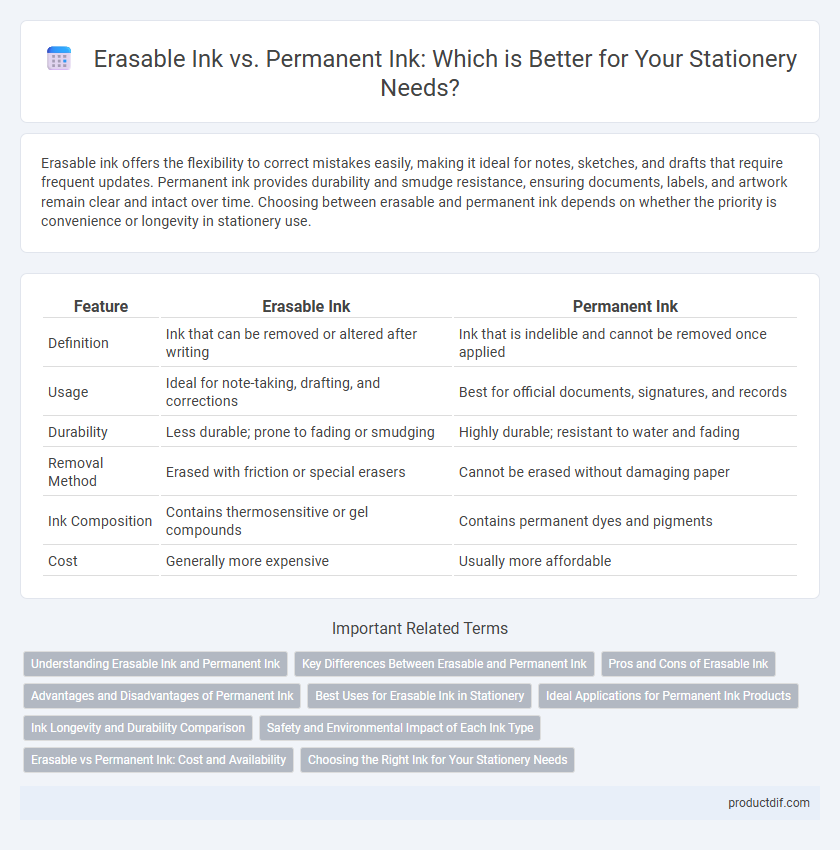Erasable ink offers the flexibility to correct mistakes easily, making it ideal for notes, sketches, and drafts that require frequent updates. Permanent ink provides durability and smudge resistance, ensuring documents, labels, and artwork remain clear and intact over time. Choosing between erasable and permanent ink depends on whether the priority is convenience or longevity in stationery use.
Table of Comparison
| Feature | Erasable Ink | Permanent Ink |
|---|---|---|
| Definition | Ink that can be removed or altered after writing | Ink that is indelible and cannot be removed once applied |
| Usage | Ideal for note-taking, drafting, and corrections | Best for official documents, signatures, and records |
| Durability | Less durable; prone to fading or smudging | Highly durable; resistant to water and fading |
| Removal Method | Erased with friction or special erasers | Cannot be erased without damaging paper |
| Ink Composition | Contains thermosensitive or gel compounds | Contains permanent dyes and pigments |
| Cost | Generally more expensive | Usually more affordable |
Understanding Erasable Ink and Permanent Ink
Erasable ink contains special polymers that allow the ink to be lifted from paper using friction or heat, providing flexibility for corrections and edits. Permanent ink is comprised of pigment-based or solvent-based formulas that bond deeply with paper fibers, ensuring long-lasting, smudge-resistant marks that resist water and fading. Choosing between erasable ink and permanent ink depends on the need for temporary writing versus durable records in stationery applications.
Key Differences Between Erasable and Permanent Ink
Erasable ink, commonly found in erasable pens, is designed with a special polymer that allows the ink to be rubbed off paper using friction, making it ideal for temporary writing or editing documents. Permanent ink, typically used in ballpoint or gel pens, contains pigments or dyes that chemically bond with paper fibers, resulting in long-lasting, smudge-resistant marks suited for official records and archival purposes. The key differences lie in their chemical composition, erasability, and durability, influencing their appropriate applications in stationery and writing tasks.
Pros and Cons of Erasable Ink
Erasable ink offers the advantage of allowing mistakes to be corrected easily without leaving marks, making it ideal for drafting, note-taking, and temporary documents. However, its main drawback is lower durability, as the ink can fade over time or be unintentionally erased, compromising document longevity. Compared to permanent ink, erasable ink is less suitable for official records or archival purposes where long-lasting, tamper-proof writing is essential.
Advantages and Disadvantages of Permanent Ink
Permanent ink offers superior durability and water resistance, making it ideal for important documents that require longevity and archival quality. Its advantage lies in preventing smudging and fading over time, ensuring that writing remains clear and legible. However, the main disadvantage is its lack of erasability, which can lead to permanent mistakes and limits corrections without damaging the paper.
Best Uses for Erasable Ink in Stationery
Erasable ink is ideal for drafting, note-taking, and educational settings where frequent corrections and updates are needed, allowing users to maintain neat and organized documents without waste. This type of ink is particularly useful in planners, calendars, and homework assignments, where information changes regularly and flexibility is essential. Its easy removability helps reduce errors and supports a more sustainable approach to stationery by minimizing paper usage during revisions.
Ideal Applications for Permanent Ink Products
Permanent ink products are ideal for archival documents, legal paperwork, and artwork requiring long-lasting, fade-resistant markings. Their water-resistant and smudge-proof properties ensure durability on various surfaces such as paper, plastic, and metal. Permanent ink is essential in professional settings where permanence and legibility over time are critical.
Ink Longevity and Durability Comparison
Erasable ink offers moderate longevity, typically lasting a few years before fading due to its less stable chemical composition, making it ideal for temporary notes or drafts. Permanent ink contains pigments and resins designed to resist water, light, and abrasion, ensuring long-lasting durability and preventing smudging or erasure on paper. For archival purposes or documents requiring extended preservation, permanent ink provides superior resistance against fading and degradation compared to erasable ink.
Safety and Environmental Impact of Each Ink Type
Erasable ink is typically water-based and non-toxic, making it safer for users and generating less environmental pollution compared to permanent ink, which often contains volatile organic compounds (VOCs) and heavy metals. Permanent inks are designed to resist fading and water, but their chemical composition can pose health risks during prolonged exposure and contribute to environmental contamination when improperly disposed of. Choosing erasable ink reduces chemical waste and supports eco-friendly practices, while permanent ink requires cautious handling and disposal to minimize toxic impact.
Erasable vs Permanent Ink: Cost and Availability
Erasable ink pens typically cost more than permanent ink pens due to specialized ink formulations that allow for easy removal. Permanent ink pens are widely available and often cheaper, as their simple chemical composition suits mass production. Consumers prioritize erasable ink for temporary notes despite higher prices, while permanent ink dominates in cost-sensitive and archival applications.
Choosing the Right Ink for Your Stationery Needs
Erasable ink offers flexibility for correcting mistakes in note-taking and drafting, making it ideal for temporary documents or schoolwork. Permanent ink provides durability and smudge-resistant properties, essential for official documents, archival materials, and artwork requiring long-lasting marks. Selecting the right ink depends on whether the priority is editability or permanence in your stationery tasks.
Erasable ink vs Permanent ink Infographic

 productdif.com
productdif.com